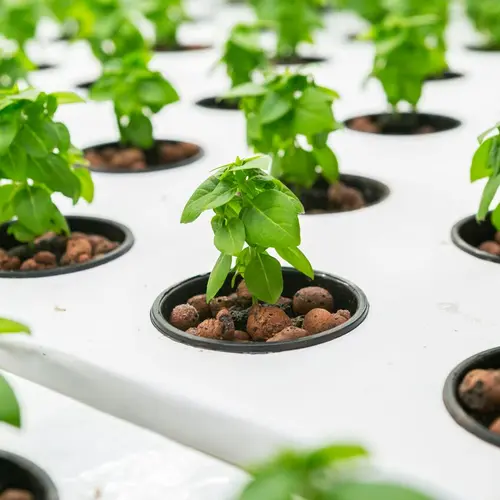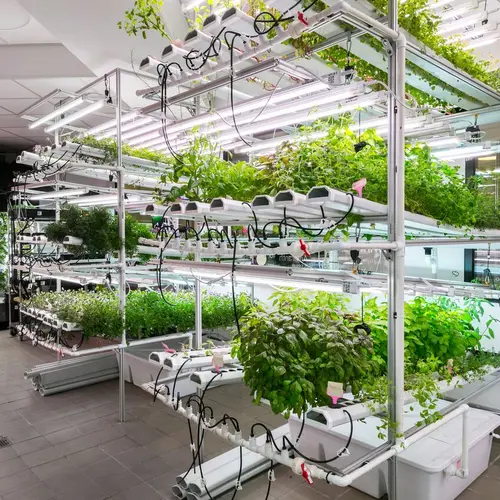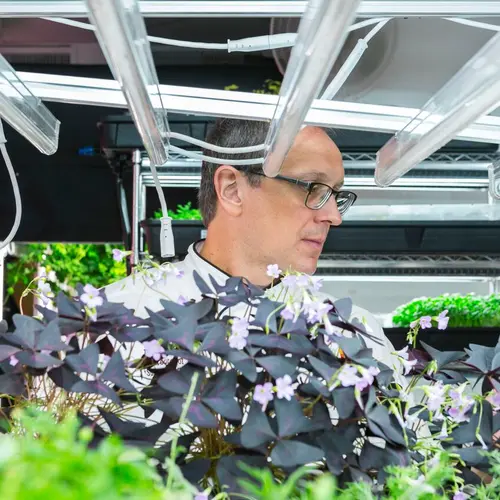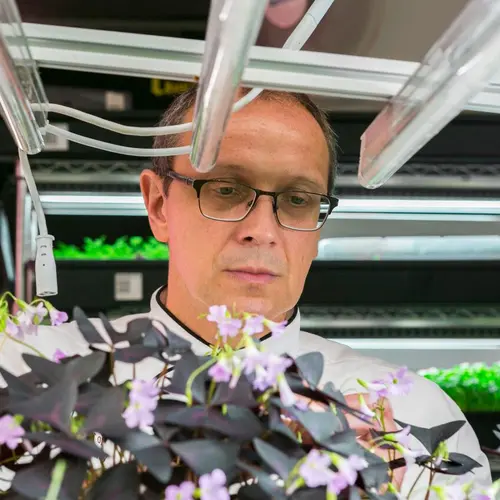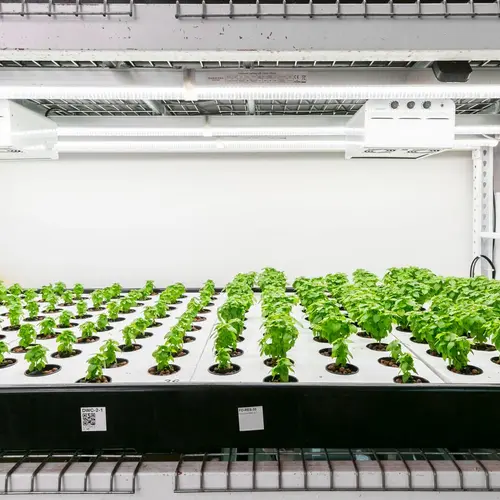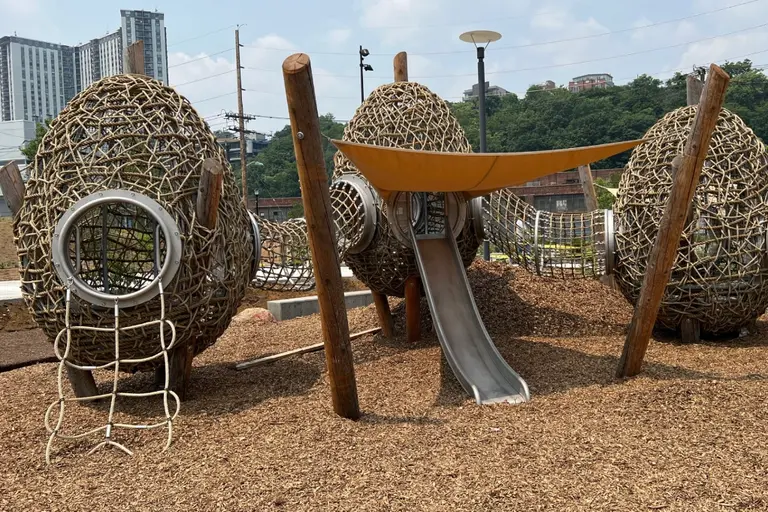Where I Work: Chef Bill Telepan takes us inside a ‘farm-to-classroom’ hydroponic garden

In his first year as the Director of Sustainability at the Institute of Culinary Education, Chef Bill Telepan has immersed himself in the school’s indoor hydroponic garden, an agriculture system that uses LED light in a climate-controlled environment. Over 50 different crop varieties are grown at any time in the garden, providing culinary students access to herbs typically not found fresh in NYC.
“As a chef, you taste things in your head and can put them all together, sort of mentally, and then prepare it,” Telepan said when asked about the benefits of the garden for students. Throughout his career, he’s been committed to using fresh, seasonal ingredients from local greenmarkets. He has worked in France under famed chef Alain Chapel, owned his own Upper West Side restaurant (Telepan) for a decade, and currently runs NYC seafood spot Oceana. Telepan gave 6sqft a tour of ICE’s hydroponic garden and told us how he became the institute’s first ever sustainability director, or as he describes it “a culmination of everything I’ve done as a chef and a person.”

New classes in hydroponic farming are now open to the general public

To date, the garden has grown over 250 crop varieties
How did you get your start as a chef?
I’ve been cooking since I was 15 years old and through high school. When I graduated, I decided to go to cooking school. I went to CIA and started working in New York at Gotham Bar and Grill. I went to France and worked at a three-star Michelin restaurant with Chef Alain Chapel. And then worked at Le Bernardin and at Le Cirque, went back to Gotham as sous chef. My first chef job was a place called Ansonia on the Upper West Side for two years. And then I ran a place called Judson Grill in Midtown for about seven years, where I got three stars from the New York Times. And then I had my own restaurant for ten and have been at Oceania for almost two years.

Hydroponic gardening and vertical farmings are sustainable methods that create optimal growing conditions for plants
I’ve always been involved, since my days as sous chef at Gotham, buying from the greenmarket because it was so close. When I became a chef, I knew from my time working in France I wanted to work seasonally and with local products. As time went on, you get to know the farmers and learn why they do it, not just to feed people but to help the earth.
So when they came to ask me to take this position, it was a culmination of everything I’ve done as a chef and a person. So I think we can help this school think in a different way and also when students come in here and when they go out into the world, they’re thinking differently than when I came into cooking school.

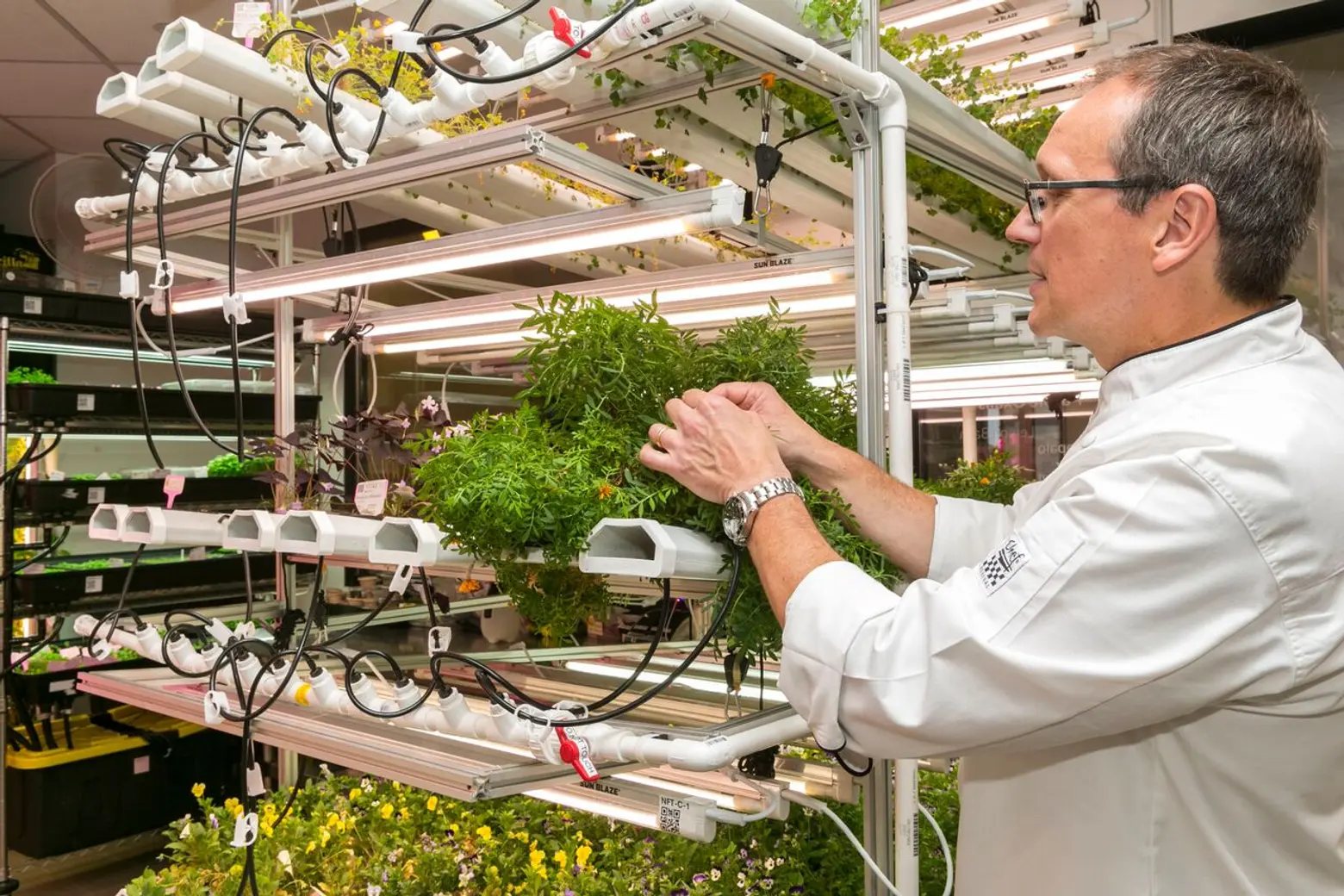

Over 50 different crop varieties are grown at one time, including herbs and greens, tomatoes, eggplants and strawberries
Can you describe what your role entails as Director of Sustainability?
As we went on it became a lot about zero waste. And putting that again in their heads as chefs. Also knowing what’s in season, things like that. I don’t think we’ll ever be sustainable ever again, since like the 1800s. But we can help do a couple of things to keep this world healthy and that’s another aspect that we as chefs, chefs are leaders in this. When you think about things like the greenmarkets that were really brought up by chefs
And 50 years ago we weren’t taught about it, but now a lot of chefs are involved in that and now it’s part of our lives. And for sustainability five or ten years from now, we’re going to be thinking about it very differently. Here, they have a lot to think about in terms of just getting knife skills correct, and properly braising and all that. But this is like something that will stick in the back of their mind.

How do we increase knowledge about food waste and cooking?
I think in terms of just getting people to start cooking, because it’s pretty intimidating, right? When I think about those things, I think about how can we get into those areas that are really needed? So it’s community centers offering free programs, cooking lessons.
My wife doesn’t really cook. She doesn’t need to, there’s a chef in the family. But for someone like her, when I was able to teach her a couple of things, she’s like oh my god it’s too much. But it’s just the matter of teaching basic things, getting people excited about it and then making something healthy and tasty. You know they put so much crap in fast food, you’re not going to create the colonel’s recipe, but you want to get it as close as possible. And give them this sense of ownership and pride. I think being able to feed your family is empowering. And I think, people also say ‘oh I don’t have time’ or ‘I’m tired,’ but the truth is there’s a lot of wasted time.
I always like to say this, if you’re going to sit around and watch TV, put a television in your kitchen and prep for the week. It can be done, but also it just takes time and there’s that intimidating factor. Learn from your ancestors, your families. Learn their recipes. My mom was a great cook so she taught all of us, not just her kids, but the cousins, her recipes. And those are things, you want not only to have because they’re real, but it’s a certain sense of community and heritage and those things are important also. And that goes back to the pride factor in the learning how to cook.

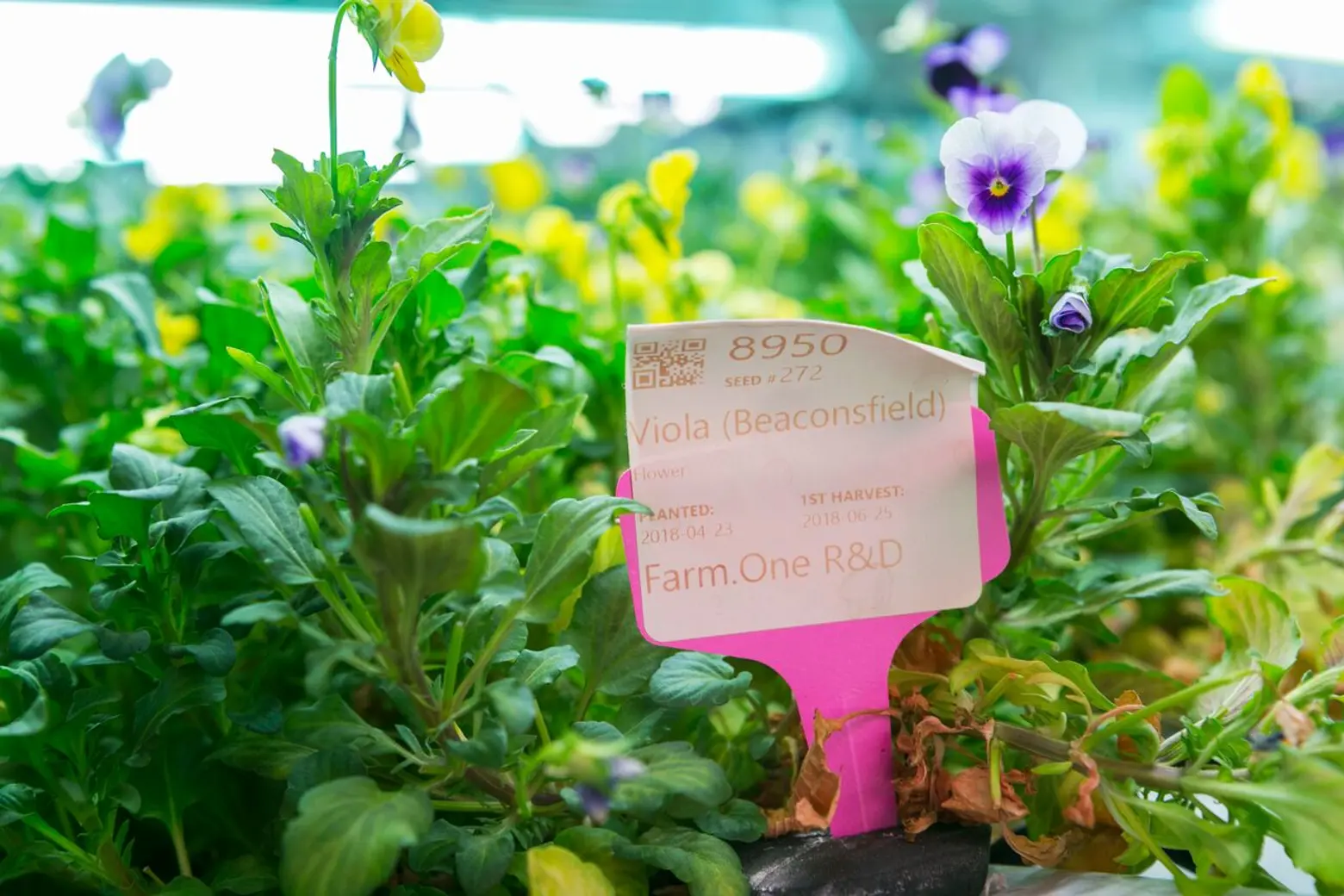
Everything is edible in the garden, including flowers
You’re the first ever director of sustainability. How did you know how to map out the role?
We didn’t. They had sort of an idea, the people who brought me on sort of had an idea, and we worked it out together and created what it is. There’s so much more we can do, or we want to do, and I think this year we have a good map of how we’re going to do that. And then hopefully, once we get that settled, then it will become since there’s a rotation of kids coming every six months, we can repeat some of the things. And it’s a building box. So we’ll do the foundation, and then hopefully keep building on new platforms and events.
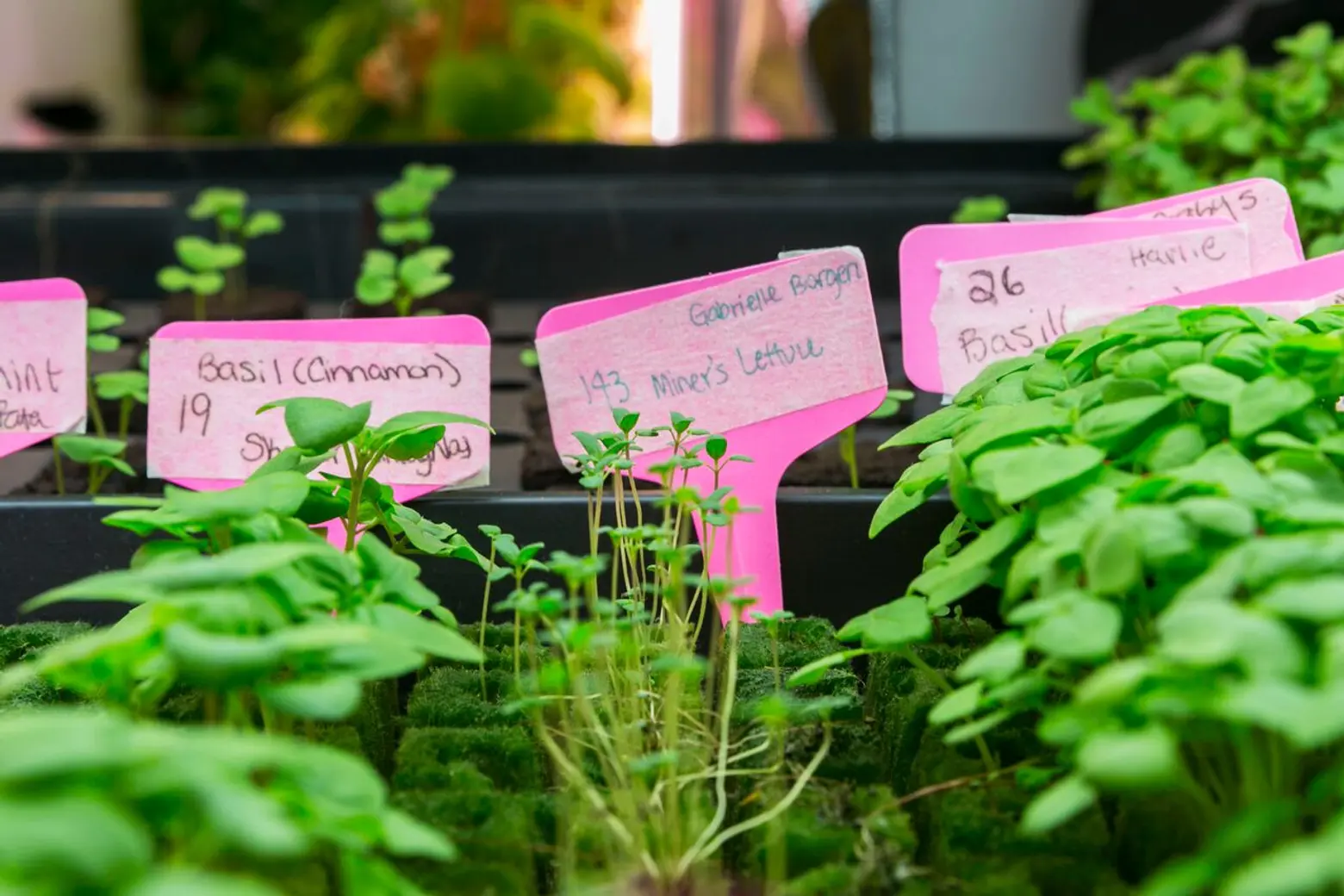
The garden has eight to 10 different varieties of basil alone
In the last year in which you have been the director, what’s been a big moment for you or an important milestone?
I think just getting the curriculum started was a big thing. The thing is everyone is busy here, and have this guy come in and say ‘let’s do this’ and the powers that be want it to happen, that was probably the most difficult transition.


What do New Yorkers need to know about food waste and how to be better consumers?
When I think about what I do, it’s a matter of asking, do I need to buy that thing? And if I do buy that vegetable or that piece of meat, how can I make it not just into one meal how can I make it into two? Or do I really need it? And figuring out ways, don’t just cut the florets of the broccoli, use it all. The stems and the cauliflowers are good. How do you take a tomato that’s sitting that you had, how do you make that into something that tastes good and don’t just throw it out?
Thinking about when you go shopping to not just buy something because it’s there and beautiful. I could go to the farmers market and buy a $1,000 worth of stuff. I used to belong to a CSA and I had to stop because I didn’t have enough time to use it all, so it was like how do I use all of this stuff? But I think that’s one way. I think also working with food pantries and helping distribute extra food to people who need it is another way they could help out.

Three (or more) important kitchen tools every kitchen should have?
Hmm, what do I use the most? A chef’s knife, a good cutting board, a peeler and a couple pieces of cooking equipment, like a saute pan.
My favorite thing is a six quart Dutch Oven from Le Creuset. Kind of expensive, but I’ve had mine for 20 years and I love it. I’ve done a lot of damage to it over the years.

+++
RELATED:
- Where I Work: Go inside Square Roots’ futuristic shipping container farm in Bed-Stuy
- How COOKFOX Architects outfitted their Midtown office with wellness technology and outdoor space
- New City Council bill would create a comprehensive urban agriculture plan for New York
All photos taken by Kate Glicksberg exclusively for 6sqft. Photos are not to be reproduced without written permission from 6sqft.
































